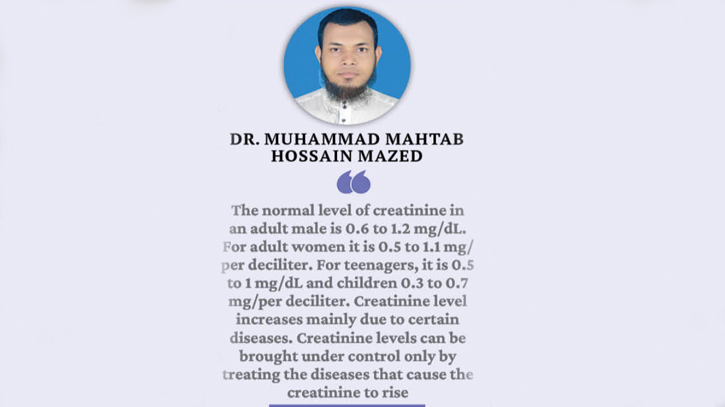
Dr. Muhammad Mahtab Hossain Mazed. Photo : TDM
Creatinine is a waste product of our body that is produced as a result of the use of our muscles. Through the blood, this creatinine reaches the kidneys, from where our body excretes it through urine. If the kidneys are not working properly, the amount of creatinine in the body increases. If the amount of creatinine in the body increases, it indicates kidney disease. In Bangladesh, the number of kidney patients is increasing recently.
Adulterated food for kidney patients, uncontrolled blood pressure and diabetes, excess protein intake, frequent urine infections and many other reasons are increasing the number of kidney patients in our homes. Diet has an important role in the treatment of kidney disease. And when the creatinine level increases, various symptoms appear in the body. Problems in urinating (frequent, painful or bloody), muscle tension, fatigue, nausea and vomiting are some of the common symptoms. Swelling around the eyes, feet and ankles are also some of the symptoms. The normal level of creatinine in an adult male is 0.6 to 1.2 mg/dL. For adult women it is 0.5 to 1.1 mg/per deciliter. For teenagers, it is 0.5 to 1 mg/dL and children 0.3 to 0.7 mg/per deciliter. Creatinine level increases mainly due to certain diseases. Creatinine levels can be brought under control only by treating the diseases that cause the creatinine to rise.
They are - diabetics, high blood pressure patients, people with low immune system, those with family history of kidney disease, people with autoimmune disorders and those who have frequent bacterial infections. So far in medical science, there is no medicine to control creatinine level, but if you control proper diet and rest the kidney, you think it is possible to control creatinine level. And in the case of kidney disease, the patient's diet is prepared by determining the amount of each nutrient properly. In this case, it is very important to follow the advice of a dietician. A little more calories are prescribed for kidney patients than other patients. The amount is 30 to 35 calories per kg of body weight. Calories for kidney patients are allocated mostly from carbohydrates. Protein control is especially important for kidney patients. The amount of protein is determined based on creatinine levels, urine microalbumin levels, urea and uric acid levels, patient's weight, etc. Usually 30 to 50 grams of protein is given in the diet for each patient. The patient's protein needs are met from animal protein. A certain amount of protein should be taken from egg whites, chicken breast meat, fish, milk or yogurt. Many patients have a misconception that 30 grams of protein means 30 grams of fish or meat. In fact, 30 grams of protein is needed for a patient in 24 hours. In this case, it is determined by calculating the weight of fish or chicken pieces. We have to remember that 30 grams of protein means 30 grams of fish, not meat or eggs. For example, we get only 3.2 grams of protein from an egg white. Amount of fruits and vegetables is determined based on blood electrolytes, uric acid and body edema. A daily intake of 40 to 60 milliequivalents of potassium is generally recommended. In this case, the dietician determines how much fruit and vegetables to eat. Apple, guava and papaya are the four fruits that are commonly given. However, it can be altered by potassium levels.
Sodium in kidney patients should also be controlled. Depending on the level of sodium in the blood, edema and medications taken, you can usually take 2 to 5 grams of salt per day. 1 spoon is equal to 5 grams.
Kidney patients have many physical weakness and other symptoms. The patient may need to take supplements or injections as per the doctor's advice, especially in case of low hemoglobin levels in the blood. But one should never take any food without knowing it may increase hemoglobin.
Although each kidney patient's diet is unique - there are certain foods that all kidney patients are told to avoid. For example: pulses, cold drinks, achar, beef, fried food, coffee, chanachur, papad, bought outside and stale food.
Diagnosis of kidney disease remains incomplete without the patient's personal and family history. In the latter case, the doctor also examines the physical and nervous system to check for signs of problems with the heart or blood vessels.
For the diagnosis of kidney disease, the patient needs to undergo some specific tests, which are: Blood tests – Kidney function tests, mainly check the level of waste products in the blood such as creatinine and urea.
Urine test – Urine sample testing may reveal some abnormalities, which may indicate chronic kidney failure and also identify the cause of chronic kidney disease.
Imaging tests – Doctors can use ultrasound to measure the exact size and shape of the kidneys. Other imaging tests may also be used in some cases.
Taking a kidney tissue sample for testing – To make a specific diagnosis, a kidney biopsy or kidney tissue is taken. A kidney biopsy is done by breaking the skin and inserting a long and thin needle into the kidney under local anesthesia. A biopsy sample is then sent to a lab to examine the kidney and find out what is causing it.
Homeo Solution for Kidney Failure and Creatinine Reduction Along with the progress of medical science in the 21st century world, homeo treatment has also made great progress. The quality of homeo medicines has improved. Homeopathy can provide quick benefits if the disease is properly diagnosed and the medicine is applied. That is why a knowledgeable, highly educated, trained doctor can take help in this regard. Homeopathy has many effective medicines for kidney failure problems and reducing creatinine.
Let's take a look at some of the effective homeopathic remedies used in kidney failure or chronic kidney disease, Lycopodium, Berberis vulgaris, Lithium carb, Sarsaparilla, Thalapsi- bursa, Epigea, Cantharis and Calcarea carb, Bellodona, Medorinum, Thuja, Baonia, Convallaria, many medicines including arum muriaticum can come on the symptoms so if you use medicine yourself without expert homeo doctor, the disease can reach a more complicated form.
Finally, kidney failure is a slowly progressive disease. So it is necessary to find alternatives for every food. Patients should be given a diet in accordance with their lifestyle and eating habits. Only then it is possible to reduce the creatinine level. Remember that if one kidney stops working, the other one can perform normal functions so treat kidney disease at an early stage and stay healthy.
The writer, an author, columnist and researcher, is Founder Chairman, Jatiya Rogi Kallyan Society
TDM/SD








